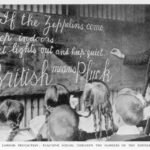
Next July, the Australasian Association for European History (AAEH) conference is being held at the University of Auckland. My abstract having been accepted, it looks like I’ll be going to New Zealand! My presentation is entitled ‘Civil defence from below: street patrols and air raid risk in Britain, 1915-1918’ and here’s what it’s about:
As a marker of total war, civil defence is usually seen as a large-scale activity organised by the state which mobilised civilians in defence of the nation against attack from above, with the development of British air raid precautions before and during the Blitz of 1940-41 as a classic exemplar. However, in Britain’s first experience of air raids between 1914 and 1918, the state was often curiously absent from civil defence. To a large extent, it was the demands of local communities which drove civil defence policy and practice. I examine here the development of street patrols, which provided warnings of impending air raids in highly localised urban areas so that inhabitants could take measures for their own protection. These patrols were self-organised, often without official sanction, and so represent a form of civil defence from below. While generally justified by a stated need to protect women, children and the elderly from unnecessary anxiety, they were also presented as a form of working-class mutual aid which was necessitated by the lack of state action in providing public raid warnings. Joining a patrol also enabled the construction of a useful masculinity by allowing men who were too young, too old or otherwise unable to join the fighting forces to perform the defence of their communities. I will focus on three such examples of bottom-up patrols with varying success – Hull in 1915, Burton in 1916, and London in 1917 – as well as an example of top-down patrols – Gloucester in 1916 – to show what they reveal about the changing geography and emotions of air raid risk across Britain in the first bombing war.
This will be a great opportunity (read: will force me!) to draw together some of the topics and themes which are emerging in Home Fires Burning. Street patrols are an understudied topic – Mike Reeve has analysed Hull’s in depth; see his Bombardment, Public Safety and Resilience in English Coastal Communities During the First World War (Cham: Palgrave Macmillan, 2021), 216–226, as well as his post on the Coastal History Blog – and they’ve cropped up here on Airminded once or twice. But they were more interesting than I’d realised. The photo above, for example, is from Hull in 1919, and doesn’t show a street patrol itself; rather, it’s children from around Church-street in Drypool, where ‘one of the best systems of night patrols was organized’, who were being treated to a ‘waggonette outing to Beverley Westwood’ out of the ‘good sum of money obtained’ from over three years’ (presumably) worth of the ‘weekly collection taken in the district’ to cover the cost of the patrols.1 This kind of unofficial, community-based civil defence was clearly very different to the patrols carried out by special constables who are usually associated with air raid patrols in the First World War, but also to the even more familiar air raid wardens of the Second World War. So I want to have a closer look.
It’s also an great opportunity to see Auckland (my only previous visit to NZ was to Wellington in 2013, also for the AAEH). It was an unfortunate coincidence that my abstract was accepted on the same day that the NZ government announced that from 2025, its Marsden Fund will no longer be funding humanities and social science research (which means, as far as I can tell, no funding in these areas at all), while 50% everything else will need to show an economic benefit to New Zealand. It doesn’t seem like there is any recourse or relief in prospect, so it’s going to get grim. (Presciently, the AAEH’s theme next year is ‘Dark Horizons? New Directions in European History’.) But I’m still looking forward to catching up with my historian colleagues across the Ditch next July!
![]() This work is licensed under a Creative Commons Attribution-NonCommercial-NoDerivatives 4.0 International License.
Permissions beyond the scope of this license may be available at http://airminded.org/copyright/.
This work is licensed under a Creative Commons Attribution-NonCommercial-NoDerivatives 4.0 International License.
Permissions beyond the scope of this license may be available at http://airminded.org/copyright/.





Congratulations!
Hadn’t heard about the funding cuts, that’s dire.
Thanks! Yeah, it’s like the pub test on steroids.